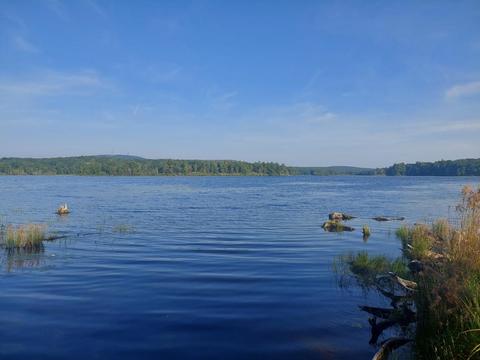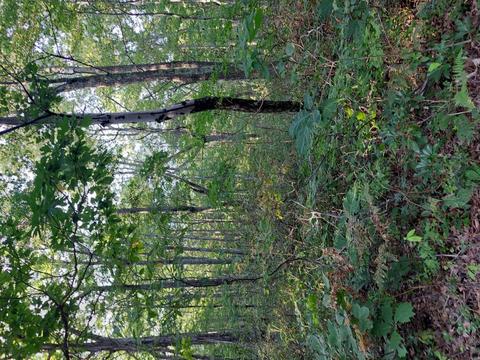
Delaware State Forest
Delaware State Forest
2174A Route 611 Swiftwater, PA 18370-7746
Official WebsiteDelaware State Forest Maps
Tips for Birding
Visitors should prepare themselves for having little to no cell phone connection while exploring tracts of the Delaware State Forest.
Proper waterproof footwear & day-packs containing insect repellent, water, and a hard copy of the Delaware State Forest Map are encouraged for all prolonged road travel & trail hiking.
Hard copies of the Delaware State Forest Map can be obtained from information kiosks located at most designated parking areas & boat launches as well as from the Pickerel Inn General Store/Gas Station beside PA-402.
Visitors should be cautious when exploring the forests in October through late December; this is when hunting season is in full swing and visitors are encouraged to wear brightly colored clothing.
There are numerous cabins/summer cottages scattered along the roadways within the Delaware State Forest; the land these buildings sit on is state-owned, but visitors should remain courteous to the properties by limiting birding efforts to roadsides, boat launches, and hiking trails.
Pennsylvania state rules & regulations apply to all visitors to the Delaware State Forest; proper licenses/permits are required for those hunting, camping, fishing, ORVing, & boating within the boundaries of the forest. For additional information on licensing, visit the websites for the Pennsylvania Game Commission, Pennsylvania Fish & Boat Commission, and/or the Department of Conservation & Natural Resources.
**Birders in search of rare & uncommon species like the Golden-winged Warbler are asked to help protect this species, and others, by avoiding the use of playback and refraining from leaving trails or roadsides to enter young growth forest ecosystems.
Road Access Information:
Visitors are encouraged to utilize an AWD or 4WD vehicle when travelling along Delaware State Forest gravel/dirt roadways; roads often become soft and muddy during the winter months thus making travel difficult. Winter season visitors should also note that several state forest roads may be left un-plowed for extended periods of time. During warmer months, road surfaces may remain problematic in that some sections are rocky; smaller vehicles run the risk of popping a tire or bottoming out. Late Fall season visitors are reminded that some of the roads will become closed and will likely remain gated until early spring. All publicly accessible state forest gravel roadways will be labeled with short wooden chocolate brown signs with white lettering; these signs may be hidden from view and are easy to drive past if drivers are not attentive.
Birds of Interest
Annual selective logging practices by DCNR & its partnering organizations have created some of, if not, the best remaining habitats for Golden-winged Warblers in Pennsylvania. Golden-wingeds are currently able to be spotted along Hay, Highline, Beaver Run, & Flat Ridge Roads as well as along sections of Pennsylvania Route 402. Unfortunately, hybridization between this species and the similar Blue-winged Warbler have led to an increase in Brewster's & Lawrence's Warbler sightings among these cuts as well. Ruffed Grouse can be heard drumming from DSF's young growth forests and double-digit tallies of Eastern Whip-poor-wills can be produced after sunset. Other notable birds among Delaware State Forest's timber cuts include both species of Cuckoos as well as Prairie & Chestnut-sided Warblers.
Birding beside dense stands of Rhododendron and Mountain Laurel often produces Canada Warblers, Black-throated Blue Warblers and an occasional Hooded Warbler. Northern Saw-whet Owls, although rarely detected, are suspected to be common within this habitat type as well. Within Hemlock stands, birders can expect to hear Black-throated Green & Blackburnian Warblers while Magnolia Warblers dominate the groves of Norway Spruce. Pine Warblers are numerous atop the White Pine forests with breeding Yellow-rumps also noticeable here, but in much fewer numbers. Northern Waterthrushes & Nashville Warblers may find their way onto checklists when birding bogs.
About this Location
**For additional information and safety tips, click the link above to visit the Delaware State Forest Hotspots Overview/Group Page.**
The Delaware State Forest (DSF) is located in the heart of the Glaciated Pocono Plateau regions of the Pocono Mountains and totals 83,519 acres within Pike, Monroe, Carbon, & Northampton Counties. It's name originates from the river that each of it's tributaries feed, the Delaware. Elevations here vary from about 1,200 ft. up to its highest peak on High Knob at 2,047 ft. The forest is managed by the Pennsylvania Department of Conservation & Natural Resources (DCNR) with occasional assistance from additional organizations for special interest conservation projects. DSF can be accessed from several primary roadways, as well as by multiple gravel roadways (often closed in winter) and multi-use recreation trails. The most contiguous and sought after tracts of DSF are those that parallel Pennsylvania Route 402 south of Interstate 84 in Pike County. A variety of forest types can be experienced here with the most prevalent being mixed species oak-maple woodlands. Northern Red Oak, White Oak, Red Maple, Black Cherry, and Black Birch are all common. Among these forests will also be dense, sometimes impenetrable, stands of Mountain Laurel & Rhododendron. In tracts of forests where fire was once common and timber harvests are still conducted, visitors can also encounter Pitch Pine & Quaking Aspen. Sections of Eastern Hemlock are still prevalent beside tributaries as are tracts of towering Eastern White Pines, but planted groves of Norway Spruce will often compose the most visible of DSF's coniferous forests.
Delaware State Forest is also known for being one of the last remaining of Pennsylvania's regions where visitors can experience glacially formed lakes & bogs; three of note include Little Mud Pond, Bruce Lake, & Pine Lake. Run-off from melting glaciers 15 to 20,000 years ago formed bowl-shaped waterbodies that were more acidic than our current man-made reservoirs. Over time vegetation progressed outward from the edge of the wooded landscapes slowly filling in the lake. Sphagnum Moss started the process followed then by an extensive list of unique plants including blueberry, cranberry, arums, leatherleaf, and the carnivorous Purple Pitcher Plant and Round-leaved Sundew. As moss and plant matter began to form layers several meters deep over the once open lake, trees began to take root. The two most famous include Tamarack (American Larch) & Black Spruce. Wild stands of these two species can only be found growing on the fringes of glacial lakes and arising from dense mats of bog moss. The cones on these trees are a valuable resource for wildlife and essential for establishing future generations of these iconic conifers.
Besides remnants of the regions boreal past, Delaware State Forest is famous for its large tracts of young growth forest. Over the past decade, DCNR has intensified its initiative to restore wildlife habitat for rapidly declining bird species. Of the most notable is the Golden-winged Warbler. Before the arrival of Europeans to the new world, naturally sparked wildfires would ravage Pennsylvania's temperate forests creating large tracts of open forest and savannah for this and other species to occupy. As human settlements arose across the region and fire suppression began, the Golden-wingeds were forced from their habitats. In response to continuing and troubling declines of the species within the current era, DCNR has joined forces with other conservation groups to create this rare fire dependent ecosystem through logging. Those exploring the Delaware State Forest can now see this near threatened species in any of the forest's clear cuts. Delaware State Forest may now not only be the last stronghold for Golden-winged Warblers in the state, but also within the Mid-Atlantic Region as a whole. Also holding strong among these forest types is the Ruffed Grouse, Eastern Whip-poor-will, American Woodcock, Eastern Towhee, & Prairie Warbler.
Recreation:
The Delaware State Forest is a great destination for any outdoor enthusiast!
Recreation opportunities currently available:
-Hunting (Licensing through PA Game Commission)
-Warmwater/Coldwater Sport Fishing (Licensing through PA Fish & Boat Commission)
-Boating (non-motorized & trolling motors) (Licensing through PA Fish & Boat Commission)
-ATV & Snowmobile Trails (Licensing/Permits through PA Dept. of Conservation & Nat. Resources) (see DSF map for appropriate trails)
-Horseback Riding (see DSF map for appropriate trails)
-Camping (Permits through PA Dept. of Conservation & Nat. Resources)
-Hiking & Biking
-Wildlife Viewing
-Picnicking
Features
Restrooms on site
Content from Official Website
Last updated February 21, 2024



